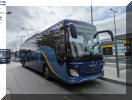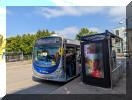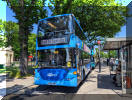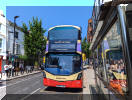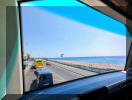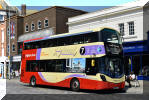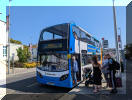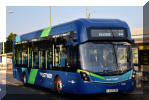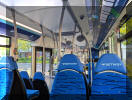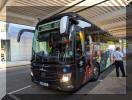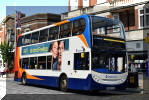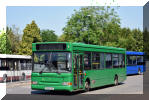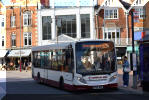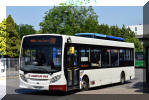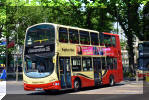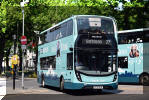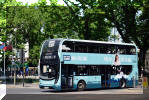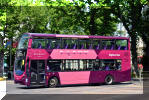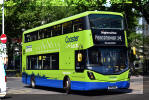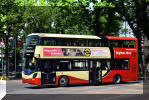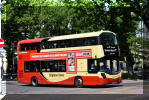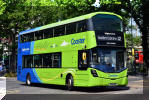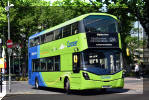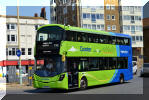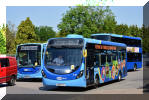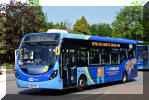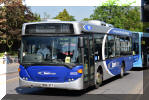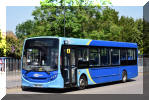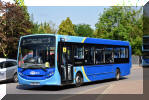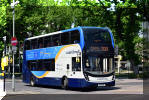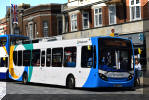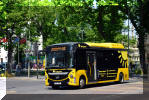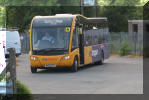Ex Tower Transit of London and
Yellow Buses Bournemouth

Brent Ricketts
New 23 plate Irizar coaches
on order four been delivered so far these being .
Two Irizar i8s in ledger luxuria livery with 31 seats
Two Irizar i6s in ledger livery with 49 seats
Four Irizar i6s in Shearings livery with 53 seats and
One Irizar i6s in Ridley’s new grey livery with 53 seats
Also I’m driving on of the i8s on Friday night so will
try and get a few pictures.



pignbob
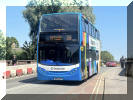
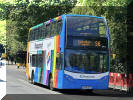
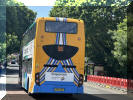
15976 by Osney Island with an
S6 on June 8th.

pignbob
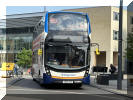
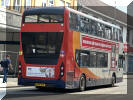
10686 works the S1 seen in Park End Street.
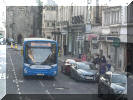
27554 with Driver Training duty in High Street on June 9th.

London operations
Andrew Webb
Final Fantasy XVI is an upcoming action role-playing
game which will be launching for PS5 players on 22 June. Go Ahead's LT67
is one of several buses to be wrapped in this advert promoting the launch.
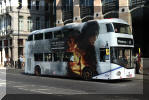
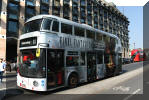
Both nearside and offside are seen passing Parliament on 10 June.
Expo 2030 is a proposed world's fair to be held in 2030. The candidate cites
competing to host the event are Busan, Rome, Odesa, and Riyadh. Busan in
South Korea has launched this campaign in London to gain support for their bid.
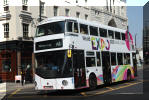
London United's LT81 passes Victoria on 10 June.
OMC Global of
Witney have taken delivery of this Isuzu Visigo, supplied by EVM. Only
launched in this country in 2022 the model is still relatively rare on the UK
and is seen in Whitehall on 10 June.
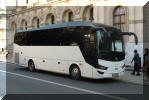
Power is provided by a Euro 6 Cummins
engine, although this has not stopped it gaining a Mercedes badge at some point
in its short life!


Allan James,
13.6.2023
City of Oxford and District Tramway Company
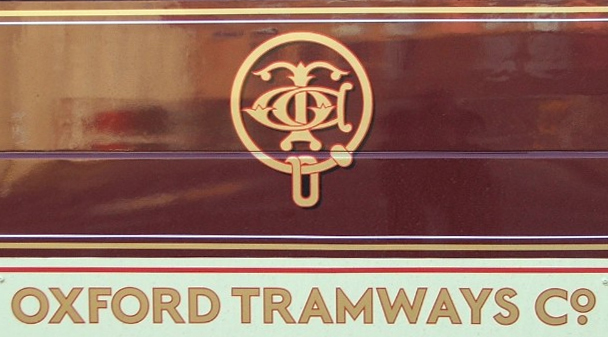
Oxford
Tramways and the arrival
of Motor Buses in Oxford
It was the
Tramways Act 1870 that paved the way for the building of street tramways
throughout the country.
So far as Oxford was concerned an approach was
made in March 1878 from a Mr. Meyer asking for a concession to run tramways in
Oxford.
A provisional order
was made by the Board of Trade in 1879 for three lines –
·
from the
Stations to Cowley Road
·
from St.
Aldates’ to Rackham’s Lane (St. Margaret’s Road) on the Banbury Road and
·
from St.
Giles’ to Rackham’s Lane via the Woodstock Road.
The
prospectus for the Oxford Tramways Company Limited was issued in January 1879
with a view to attracting capital of £42,000.
It extolled the virtues of Oxford, naming
every building which might produce revenue.
It was expected that completion would be by
the end of July 1880.
The company ran
into financial difficulties and went into liquidation in May 1881.
Meanwhile, in
January of that year another company, The City of Oxford and District Tramways
Company Limited was formed this time with a capital of £40,000.
It took over the provisional order of the old
company.
This new company lost no time in commencing the work
and the first line – from the Stations to Cowley Road was opened on 1st
December 1881.
The second line –
the Banbury Road line followed on 28th
January 1882.
The third line on the Woodstock Road was
abandoned.
At this point
mention should be made of Magdalen Bridge.
It was proposed to widen the bridge by 20 feet
and the company had agreed in April 1881 to take up and relay the tramway on the
bridge when it was widened and to provide £2,000 towards the cost.
The provisional order provided for a double
line over the bridge.
Both the council (then the Local Board) and
the Company felt that a single line with a passing place in the centre of the
bridge was sufficient.
The sticking point came over the surplus
materials which the Board claimed and valued them at £400.
The Company wanted them for the Walton Street
extension which was proposed.
There was a long and acrimonious exchange in
which neither party would back down, so arbitration was proposed. That, too,
broke down, so the matter went to court.
The result was that the court said there was
no binding agreement for a single line and therefore a double line must be built
in accordance with the provisional order. It was later agreed that the company
were to purchase the surplus materials for £100.
The new double line over the bridge was opened
for traffic in May 1885.
Meanwhile, in
November 1882, the company applied for a provisional order for an extension
along Beaumont Street, Walton Street and Kingston Road to a point near Leckford
Road.
This was inspected and
opened on 15th
July 1884.
In November 1885 an application was made for a
further provisional order to extend the St. Aldates’ line to Hinksey (Lake
Street) which was formally opened on 15th
March 1887.
Then came 10 years
of consolidation. Traffic increased from around 1m to over 3m in the years 1896
and 1897. Omnibuses and brakes were introduced in 1894-6 on services to
Summertown, Woodstock Road and Iffley Road. There was considerable activity in
the City around this time. In 1896 St. Martin’s church at Carfax was demolished,
leaving just the Tower. The new Town Hall was opened by the Prince of Wales in
1897 amidst great celebration.
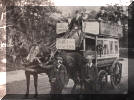
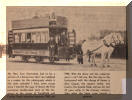
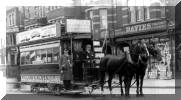
In 1895 came
the first real signs of discontent with the tramways. In a letter to the
newspapers a councillor wrote about powers under the Tramways Act for the
council to purchase the tramways on very advantageous terms after 21 years from
the provisional order.
This came as a bit of a bombshell to the
company who offered to extend the Summertown line from St. Margaret’s Road to
South Parade in exchange for an extension of their franchise until 1907.
The council agreed to the suggestion but added
that a rental of £200 per annum should be paid by the company from 1898, along
with 12½% of the profits over £3,000.
The tramway was
extended to South Parade on 5th
November 1898.
The company
recognised that electrification was approaching and wrote in 1902 proposing an
extension of the tramways and electrification. Their proposal included (1) an
extension from Kingston Road via Leckford Road, Woodstock Road to Squitchey
Lane, Summertown (2) from South Parade to Hernes Road (3) from Cowley Road to
the city boundary, Barracks Road (4) from Magdalen Bridge to the city boundary,
Iffley Road (5) in Abingdon Road to Sunningwell Road and (6) from the Stations
to Binsey Lane.
The council resolved that it was not prepared
to entertain proposals for the extension of the Tramway Company’s tenure.
In 1903 the
Council decided to purchase the tramways and instructed the Town Clerk to make
provisional arrangements with the Company to do so.
In 1904 the
council received its first application for a motor-omnibus service from a
Captain Shipley.
It took the council over 6 months to reply to
the application and then rejecting it out of hand. But Captain Shipley did not
do his cause any justice by presenting a bus for inspection which was not of the
type he was proposing to use!
It was not
until June 1905 that the Council resolved to enter into a provisional agreement
to take over the tramways in December 1906.
That meant that 9 months’ profits would have
to be paid to the shareholders until September 1907.
Following on
from that resolution, the Council asked two engineers if they could advise on
the form of traction most suited to Oxford. Their reports were received in
September.
They were completely different, one, Stephen
Sellon, recommending electric tramways, and the other, Worby Beaumont, motor
buses.

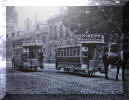
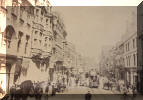
The Council then
decided to promote a Bill in Parliament to give them the widest powers in
relation to the tramways, without pledging whether they should work or not work
the tramways themselves. Five new or extended routes were included
(1)
along
Iffley Road to Iffley Turn
(2)
from St.
Clement’s up Headington Hill to Windmill Lane
(3)
extension
of the Banbury Road line to Hernes Road North
(4)
extension
of the Kingston Road line to Polstead Road
(5)
extension
of the Abingdon Road line to Weirs Lane
Under the
Borough Funds Act 1903 the Council had to hold a meeting of electors and obtain
their consent to the promotion of a Bill.
This meeting was held in January 1906 in the
Town Hall - which was full with several hundred people unable to get in.
When Alderman
Hall
spoke in favour of motor buses he received rapturous applause, while those who
spoke in favour of trams were heckled or shouted down. When the matter was put
to a vote there were only about 80 or 90 in favour and between 1,500 and 2,000
against.
The Council
now faced a dilemma and held a special meeting the following week to consider
their next steps.
The Tramways Committee recommended that the
Council should ask for a poll, Alderman Hall said they should regard the result
as final and not require a poll.
His proposal was adopted.
However, 127 names were assembled asking for a
poll which, under the Act, had to be held if 100 or more electors require it.
The poll was held later that month and the
result equally crushing with 5,092 against and only 1,117 in favour.
The Council
was now saddled with an obsolete tramway system. Their proposal for an electric
tramway system had been roundly defeated.
So where do they go from here?
The Bill was
withdrawn. Public opinion was that electric tramways were not the answer, or at
least that was how some saw it.
The Council viewed it differently.
They considered the vote was on the question
of expense to the ratepayers, not as trams versus motor buses.
This prompted
an approach from the Tramways Company to extend the present system and its
conversion to electric traction, and two approaches to run motor buses.
There
was also a letter from a Mr. Cownie of the National Electric Construction Co
asking for details of the proposal to extend the existing tramway system.
The Council
recommended that a committee be appointed to consider the best mode of dealing
with the Tramways Company’s undertaking and further report on the possibilities
of introducing a motor bus service in the City.
Some councillors urged a further referendum of
the ratepayers, this time on electric trams versus motor buses.
The Council, however, resolved to appoint a
new committee to report on the financial gain to the ratepayers offered by an
electric tramway system in regard to road maintenance, rates, rent, and
provision for the tramway purchase money and as to the probability of obtaining
an equivalent payment from a motor omnibus company. These terms of reference
were so skewed against motor buses, that some councillors refused to serve on
the committee.
Following
Counsel’s opinion the committee came to the
conclusion that a lease to a company for electrification could provide purchase
money for the present undertaking, expenses already incurred on the defunct
Bill, saving in cost of maintenance of the roads, a rent or royalty for the
concession and additional rateable value to the City.
No such payments can be obtained by the
adoption of motor omnibus traction.
The Council
agreed to invite tenders for the lease of the undertaking for the purpose of
electric traction in May 1906.
Two tenders were received.
(1)
from the
National Electric Construction Company advocating the use of the “Dolter”
surface contact system throughout including extensions to the existing system
which went outside the City boundary
(2)
from the existing Tramways Company proposing a
mixture of a surface contact system in the centre of the City and overhead wires
outside. The Council asked Mr. Sellon’s opinion.
He said that the Oxford Company offered a
sound business proposition which provided adequately for the needs of the City.
The National company’s scheme is not so
advantageous as some of their proposed extensions are a waste of money, at any
rate, for many years to come.
In October,
1906 the Council ignored Mr. Sellon’s advice and accepted the tender of the
National Electric Construction Co. to use the “Dolter” system.
A new Bill was promoted in Parliament. This
was opposed by the existing Tramways Company, but to no avail.
The Council did get
a clause inserted that the “Dolter” system must have been working satisfactorily
anywhere in Great Britain for six months by 1st
January 1908 otherwise a different system must be used.
The Act, which became law in August 1907, also
provided that the Council’s rights to purchase the undertaking be postponed for
42 years from the passing of the Act.
This was to have a bearing on the development
of motor buses in Oxford in later years.
There were
problems in getting guarantees and finance for the project and in paying off the
old Tramways Company.
The Council insisted on a penalty clause of
£100 per week if the works were not completed within 15 months of the agreement.
In December
1907 a deputation went to Hastings to look at the “Dolter” system there.
Although the cars were smooth enough, there were four men on patrol per mile to
neutralise any live studs and the system required 25% more electricity than the
average.
The Council resolved unanimously that it was not
working satisfactorily. So, another dilemma – what now?
It was
September 1908 before the NEC Co. wrote to the Council suggesting a combined
conduit and overhead system. Without any agreement with the Council, the NEC Co.
promoted a Bill, which became law in August 1909, to give effect to this new
suggestion.
The NEC Co. said that the penalty clause was
putting off investors, so they included a reduction to £25 per week in the Bill
along with 3 years for completion.
All was quiet
until October 1911 when Mr. Cownie said that finance was still not in place.
He suggested an overhead system throughout to
save costs – and one which might be more attractive to investors.
It was at
this time that the Council began to take the licensing of motor buses into
consideration. The Watch Committee, which was charged with the duty to consider
applications, was adopting a rule that the number of vehicles should be limited
to the requirements of the city.
It was for that reason that they were refusing
every application thus far.
1912 came
with a new proposal from the NEC Co. that the Council should provide the capital
as it could raise the money at far better rates than the company could.
This was summarily rejected by the Council.
Of course by now the 3 years for completion
was running out. After August the Council considered enforcing the penalty for
non-completion, but decided to defer it.
And so things
drifted into 1913. The NEC Co. now suggested a petrol-electric system, using
petrol in the centre of the City and overhead wires outside, supplemented by
motor buses on other routes.
There was
growing dissatisfaction with the horse trams.
This was
exacerbated by a strike of tram drivers and conductors on Easter Monday, 24th
March. The strikers were dismissed and replaced within two days and services
soon returned to normal.
Although there were some angry scenes, the
strike was eventually abandoned in May.
The
petrol-electric proposal was eventually rejected by the Council in November, and
the Council said that no further negotiations with the Company should take
place.
That ought to have been an end to the matter, but no.
Behind the scenes the Tramways Committee were
still in negotiations!
Sensing the end
game, Mr. Cownie wrote immediately afterwards offering to supply a service of
motor buses within six months, offering to sell the track to the Council for
£20,000, although he still believed that trams were the best solution and was
looking at battery=powered cars.
At the same time Mr. W.R. Morris wrote to the Council
asking for a licence to sun six motor buses. When he received no reply to his
application, he commenced a service on 5th
December using a coupon system.
Coupons could be purchased from a number of
shops on the route, and no money was accepted on the buses.
Upwards of 17,000 coupons were issued that
weekend.
On 30th
December the Tramways Company (NEC Co) started its own bus operation, issuing
tickets in the usual way, competing with Morris on the key routes. Morris later
stopped using coupons and issued tickets in the same way.
The Council
decided that it must do something about the licensing of buses.
It had applications from four companies.
Eventually the General Purposes Committee
decided that 12 licences should be granted to the Oxford Motor Omnibus Co
(Morris) and 12 to the Tramways Company.
Morris wanted a
monopoly of licences, and when he did not get it, he withdrew from the contest
and sold his business to the Tramways Company at the end of January 1914.
The Tramways
Company then promoted another Bill in Parliament which came into force in August
1914 giving powers to operate trams or buses, or to abandon the tram system.
It gave them the exclusive right to run buses
for 37 years (being the remainder of the 42 years provided in the Act of 1909).
In return it handed the tracks over to the Council free of charge.
Despite the onset of motor bus competition some trams
lingered on and it was not until 8th
August 1914 that the last tram was taken off the road. The euphoria of a full
bus service was not to last long as 12 of the buses were commandeered for the
war effort in October 1914.
The City of Oxford
and District Tramways Company, which had been set up by the NEC Co., continued
to run buses until 1921 when its name was changed to the City of Oxford Motor
Services Limited.
If any readers would like a long version
of this paper(180 pages)with newspaper reports set out in full please contact
allan.b.james@btinternet.com
for an
e-mail copy.
Gavin Francis
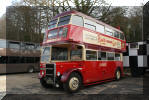
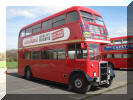
Barton 1019 at Brooklands, I did not realise it had been
in preservation as RTL 326. A couple of pictures attached.


Alan Whittaker
I was in Chemnitz, Germany, on 3rd June for the 7th
meeting of The Friends' Circle of Ikarus Buses. There were over 40 buses on
display and several of them were offering rides. Most were from the former DDR,
although some came from as far afield as Poland and Hungary. The highlight of
the day for me was a chance to have a ride in a legendary Ikarus 55, one of the
first rear-engined buses anywhere in the world. The event was held in the city
bus company's garage, and there was also a chance for a tour of the workshop.

%20A%20Whittaker_small.jpg)
%20A%20Whittaker_small.jpg)
%20A%20Whittaker_small.jpg)

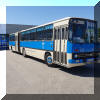
%20A%20Whittaker_small.jpg)
%20A%20Whittaker_small.jpg)
%20A%20Whittaker_small.jpg)


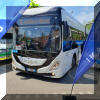
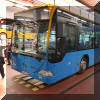
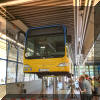
The pictures show the variety on show.


Michael Penn
Cardiff and Barry Island
Some photos for you from
Cardiff and Barry Island this last weekend. Apart from all the normal
stuff there was a rail replacement operation going on between Cardiff and
Bristol via Newport. There were a number of coaches involved and some
buses although I couldn’t identify the operators of some of them. Perhaps
some of your readers could help.
There were two Enviro 400s –
LJ 09 CEF and LJ 09 OLO originally owned by Travel London and later by Green
Transport of Hockley in the West Midlands. I think they are probably still
owned by Green Bus?
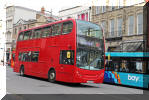
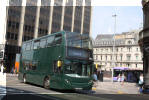
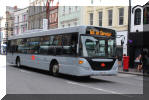
CN 57 BJF was a Cardiff
Scania now owned by Teulu of Trelaw who seem to be assembling a fleet of rail
replacement buses in this livery.
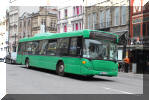
YN 57 FZY was a Newport
Scania. The current operator is not known.
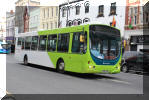
BX 56 XBY was a Volvo B7RLE
originally owned by West Midlands Travel. The current owner is not known.
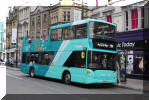
Apart from the rail
replacement buses Cardiff City Transport 399 (YR 59 FYV), an ex London United
Scania N230UD newly converted to open top, was on its first day in normal
service.
At Barry Island for the rally
on Sunday were the following:
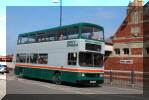
B868 XYR was a 1985 Volvo
B10M-61 rebodied with an East Lancs double deck bus body for London Transport
tendered bus services in 1992.
The reduced rear overhang is noteworthy.
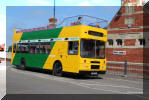
D705 GHY was an Alexander
bodied Volvo B10M-50 new to Badgerline.
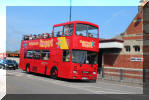
F41 YHB was an Alexander
bodied Scania N113DRB new to Newport Transport.
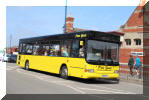
AE 51 VFV was Dennis Dart SLF
new to Cavalier (trading as Huntingdon & District) later passing to Stagecoach
in the Fens.
It then passed to Fleet Buzz which had been acquired by
Stagecoach.
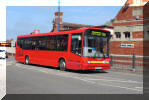
RG 51 FWZ was Marshall bodied
Dennis Dart SLF new to Centrewest as 133 CLT.
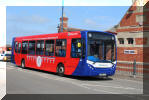
CN 60 CVG is Red & White 27689 is in a special livery
commemorating the coronation of King Charles III.
A nice day out from Michael Penn.
Jack Cooper



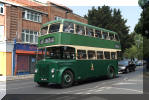
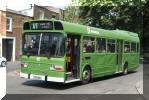
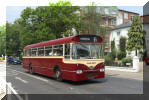
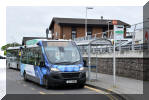


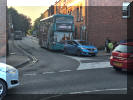
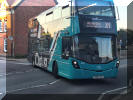
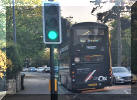
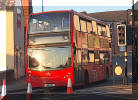


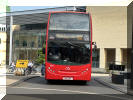
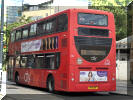

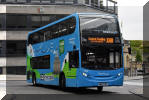
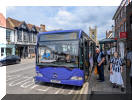
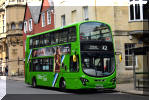
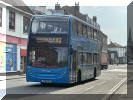
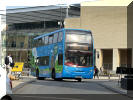

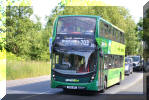

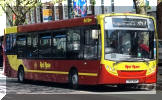

























%20A%20Whittaker_small.jpg)
%20A%20Whittaker_small.jpg)
%20A%20Whittaker_small.jpg)


%20A%20Whittaker_small.jpg)
%20A%20Whittaker_small.jpg)
%20A%20Whittaker_small.jpg)






